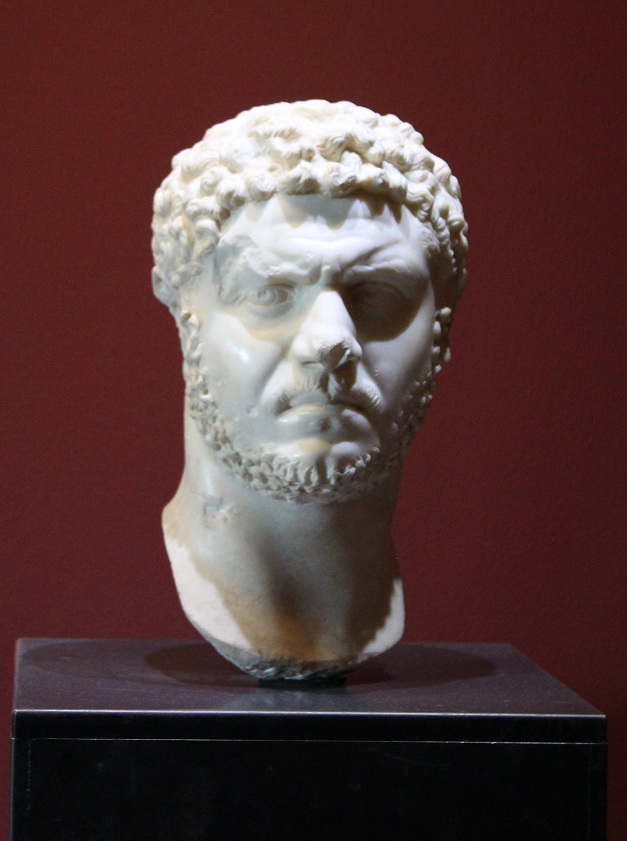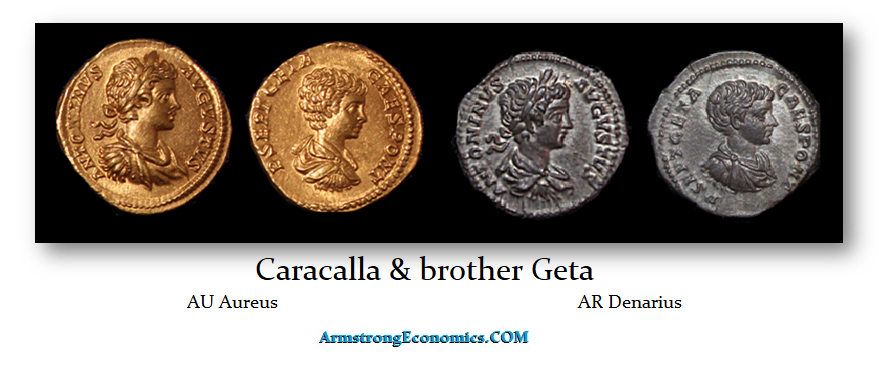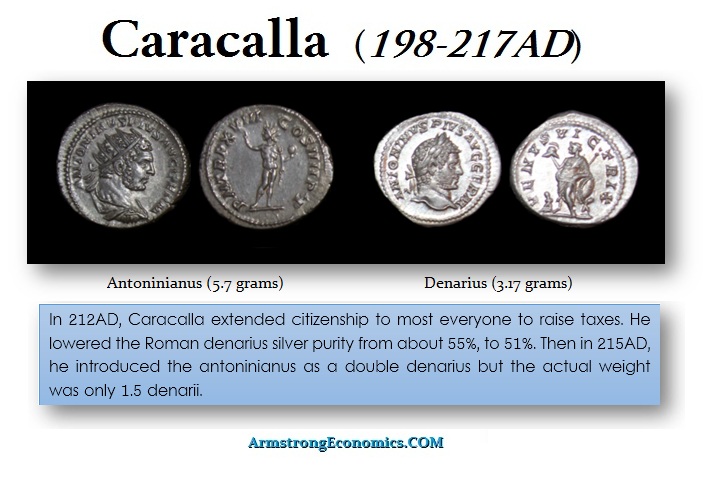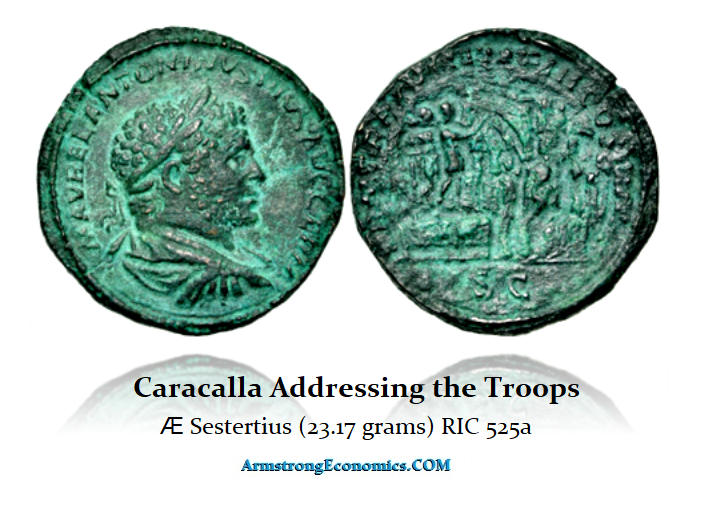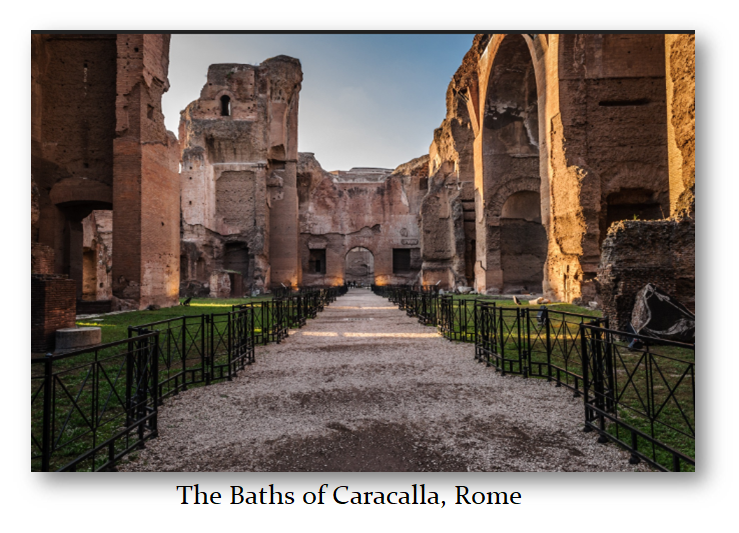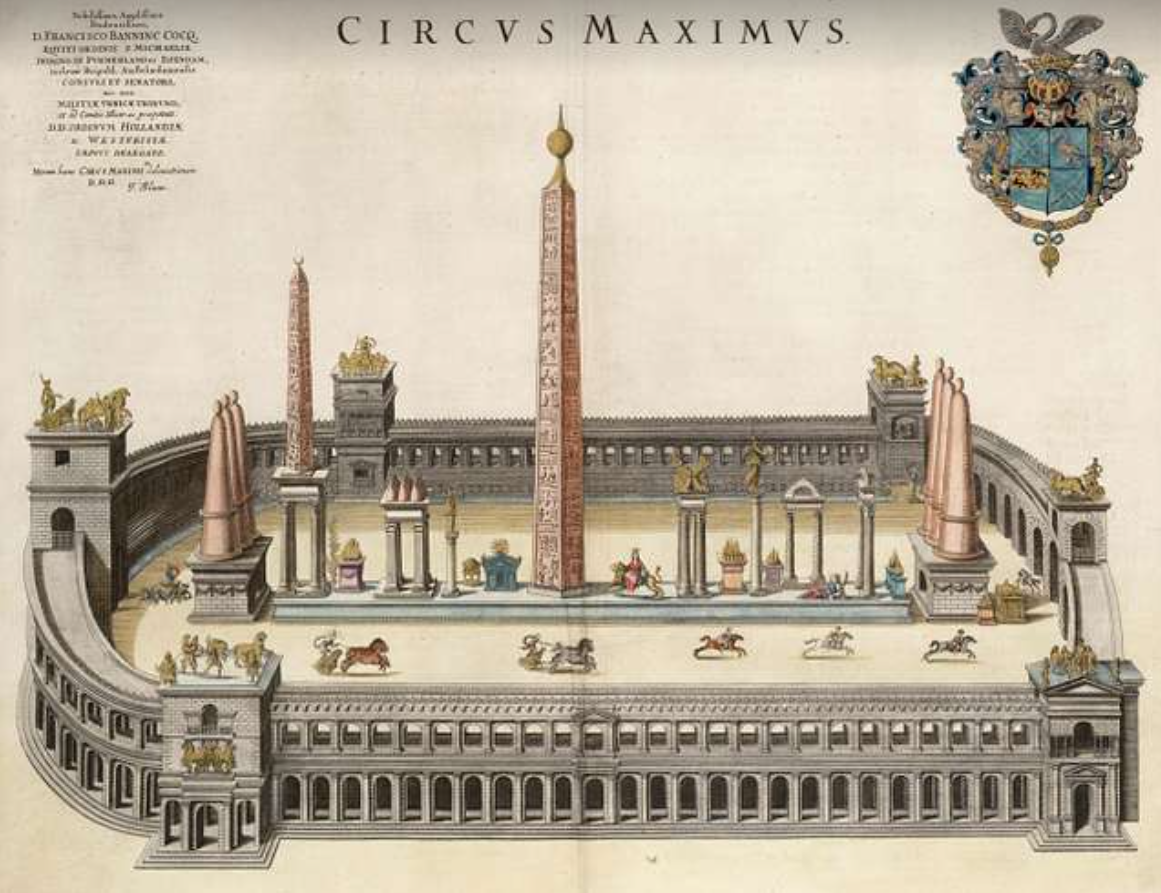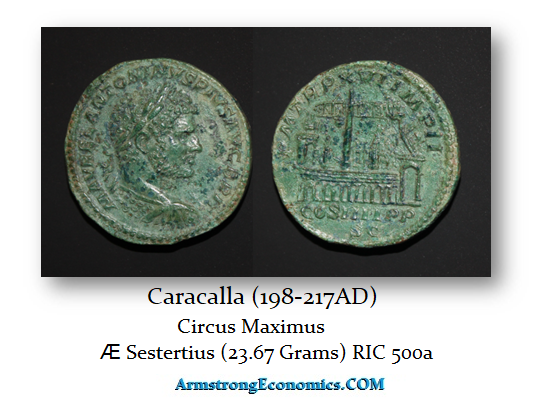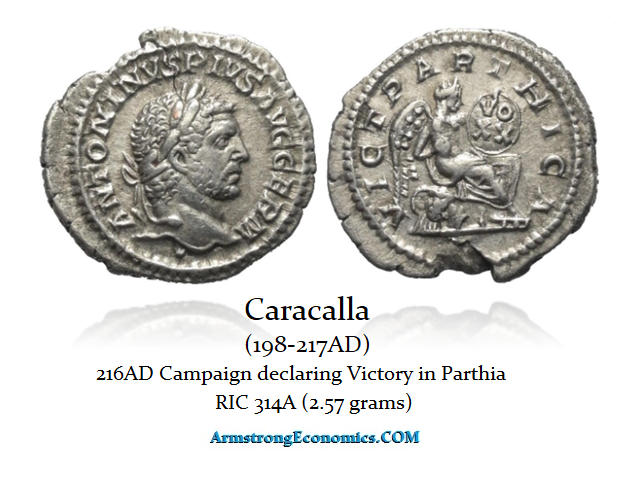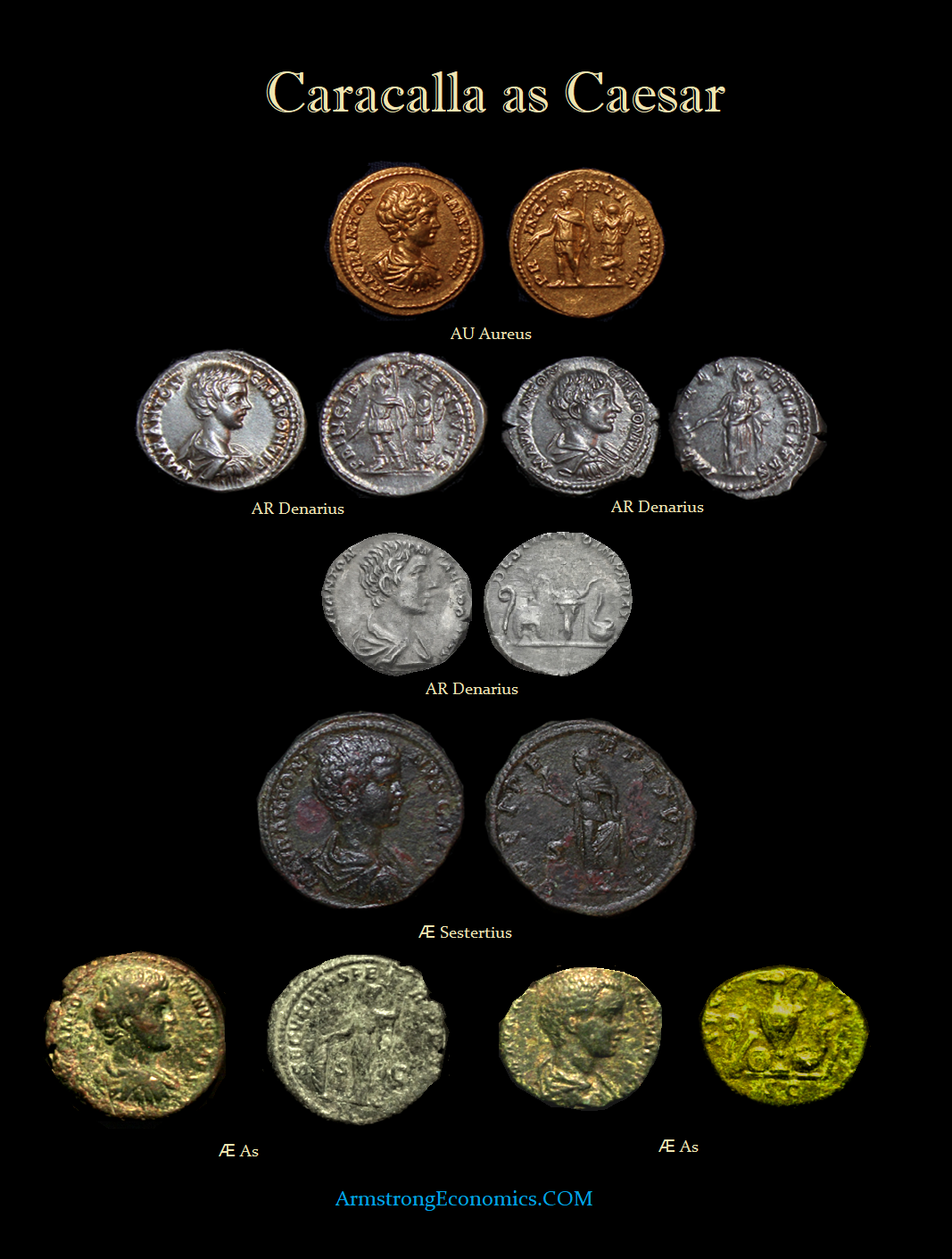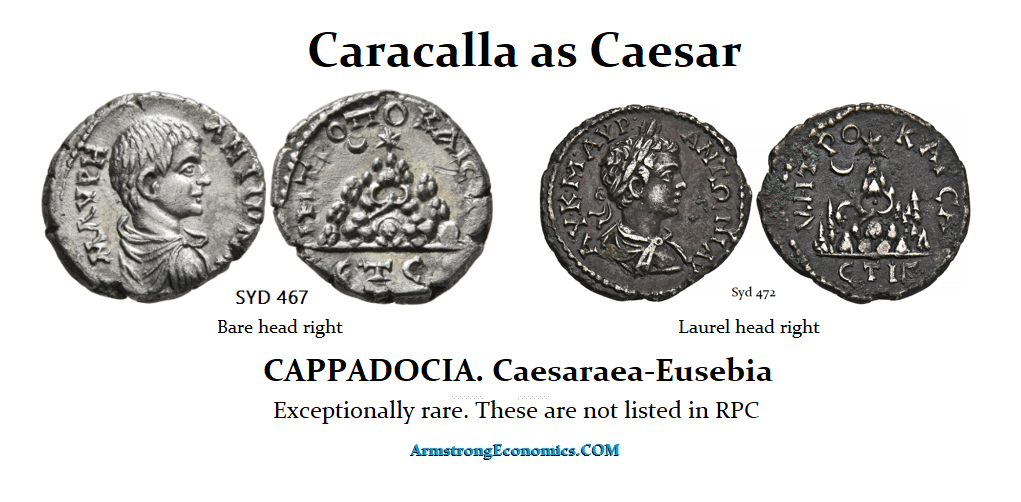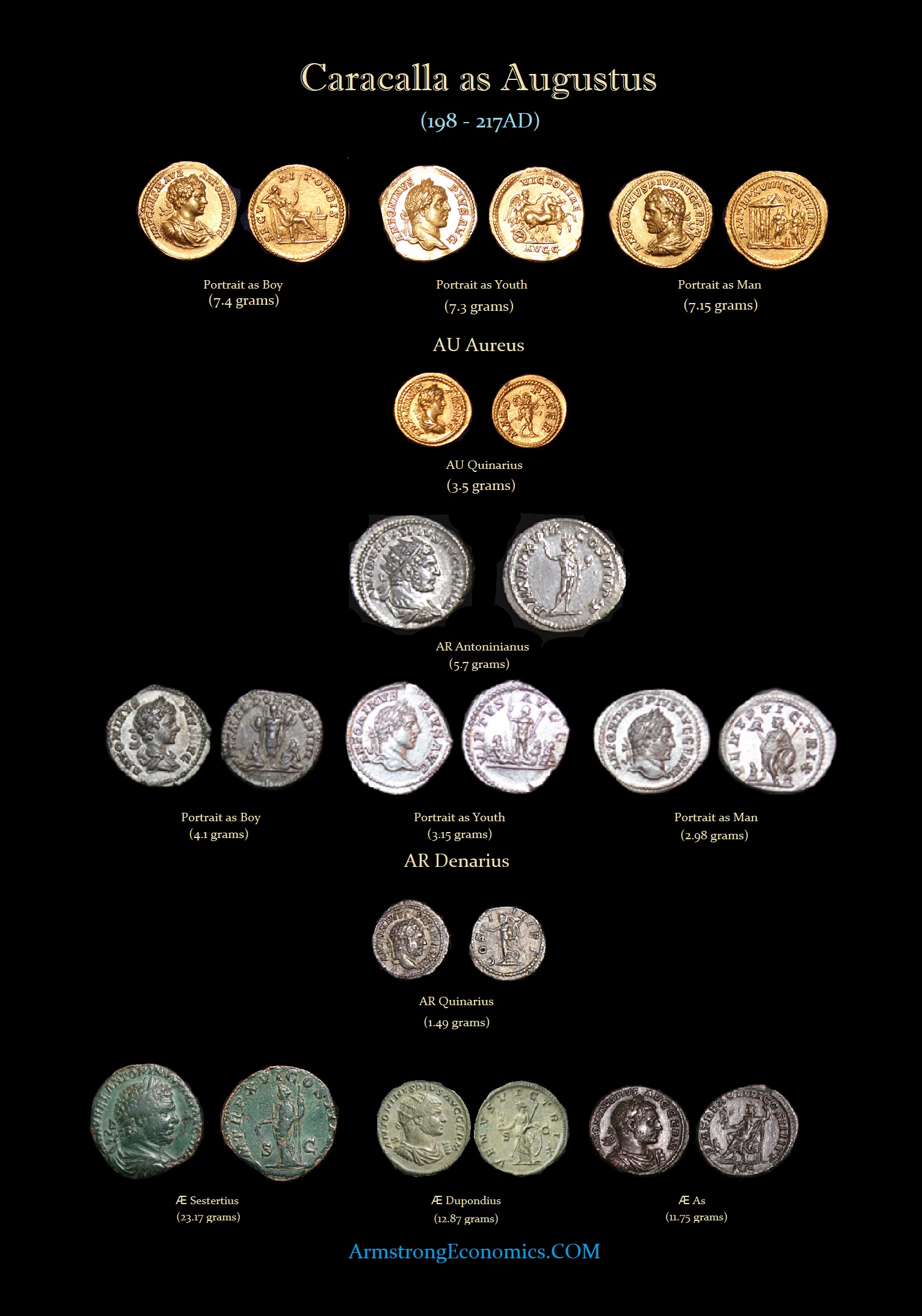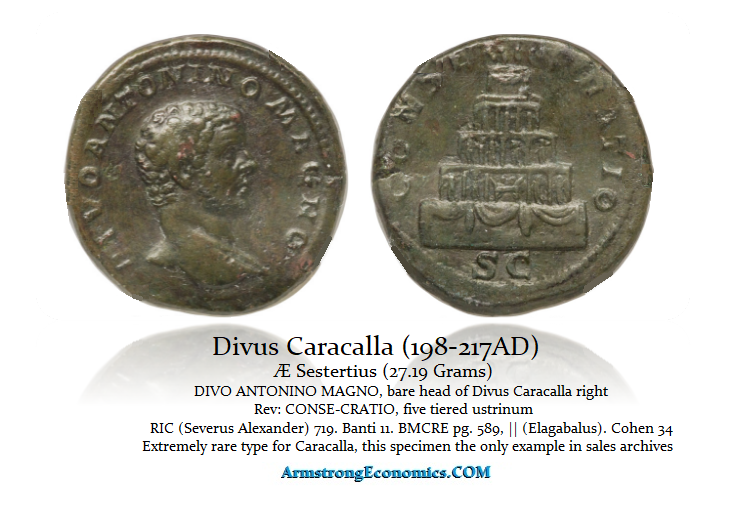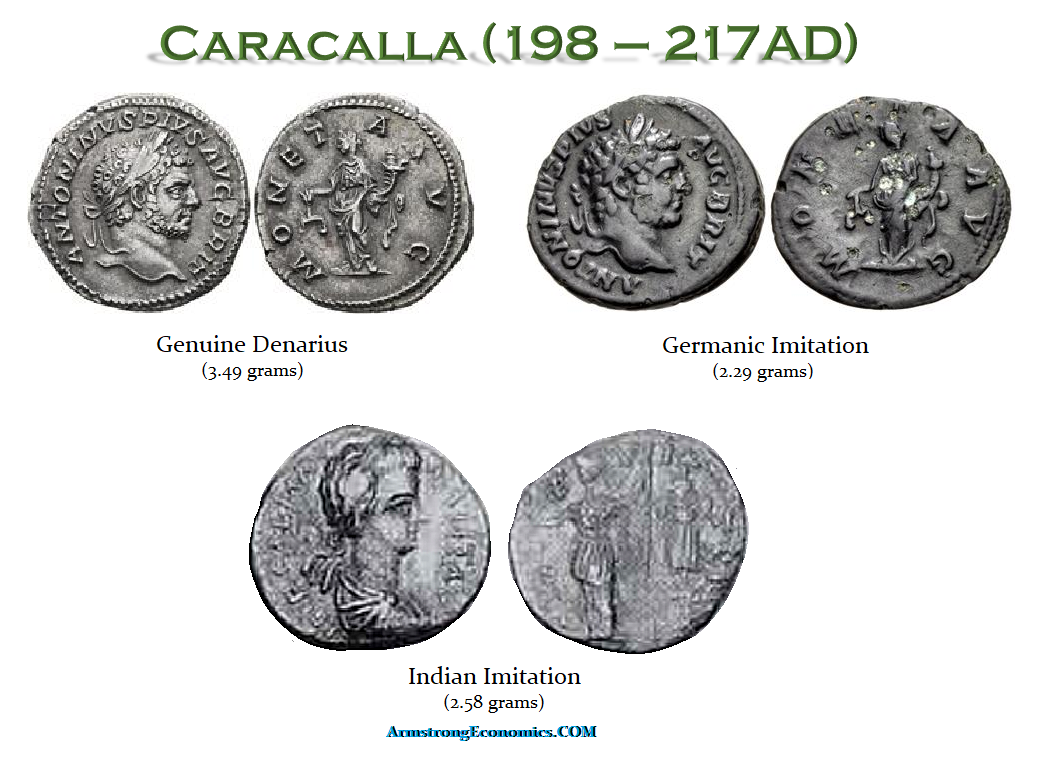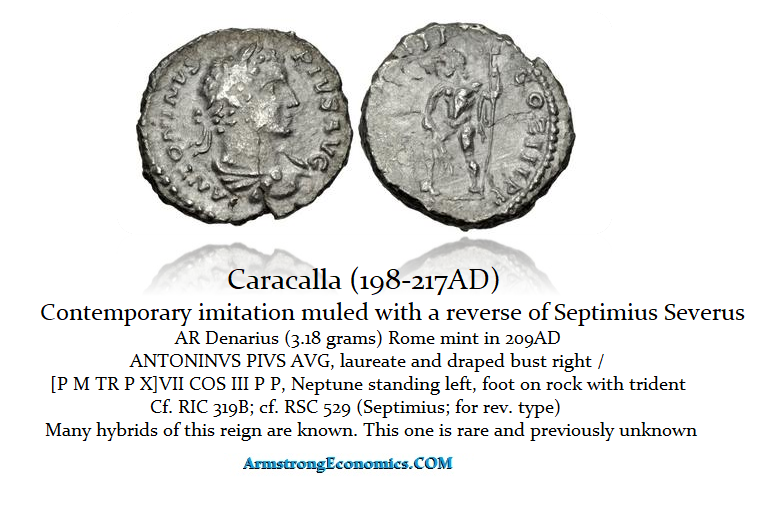Caracalla
198-217 AD
Son of Septimus Severus
Marcus Aurelius Antoninus, originally named Julius Bassianus, was born at Lugdunum, Gaul, on April 6th, 188 AD. He was the elder son of Septimius Severus and Julia Domna. His original name, Bassianus, came from the Syrian side of his family. Following the Civil War in the aftermath of Commodus’ murder, his father attempted to strengthen his imperial line to establish a Severan Dynasty by raising his son to the rank of Caesar (or junior emperor) in 195 AD. Thus, Caracalla was given the rank of Caesar two years before his brother Geta, who would be his most hated enemy.
 In 197 AD, Caracalla was given the title of Designate, a clear sign that he was to succeed his father. The following year, 198 AD, he was raised to the rank of Augustus once again ahead of his younger brother. Clearly, Caracalla was Severus’ favorite of his two sons. His father’s preference for Caracalla over his brother Geta led to palace intrigues, casting the two brothers against one another despite their mother’s attempts at intervention.
In 197 AD, Caracalla was given the title of Designate, a clear sign that he was to succeed his father. The following year, 198 AD, he was raised to the rank of Augustus once again ahead of his younger brother. Clearly, Caracalla was Severus’ favorite of his two sons. His father’s preference for Caracalla over his brother Geta led to palace intrigues, casting the two brothers against one another despite their mother’s attempts at intervention.
The Praetorian Prefect Gaius Plautianus conspired to improve his already considerable powers by wedding his daughter Plautilla to Caracalla in 202 AD. Despite Caracalla’s resistance to the marriage, his father needed the support of Plautianus. Regardless of his father’s wishes, Caracalla treated his bride contemptuously and secretly plotted against her father, perhaps out of revenge. Accounts varied as to how Plautianus fell from grace in 205 AD, but the prefect’s death was filled with joy by Caracalla, who wasted no time in exiling his wife while he patiently awaited his father’s death.
Septimus Severus waged a long campaign in Britain between 208 and 211 AD. As part of his father’s victory, Caracalla received the title of Britannicus in 211 AD. However, due to his father’s ill health, Caracalla was forced to conduct many of the campaigns in his place, which earned him the loyalty of the legions in the field. The name “Caracalla,” by which he is best known to posterity, was a nickname given to him by the troops derived from the hooded cloak he wore.
Septimus Severus died in Britain at Eburacum (York) in 211. The troops who had followed Caracalla faithfully refused to show the same favoritism that his father had when it came to his brother. The Guard and the legions had sworn an oath to both sons of Severus, which did not please Caracalla in the least.
Geta had been given the rank of Caesar in 198 AD. However, he was not raised to the rank of Augustus until 209 AD. Herodian tells us that the two brothers proposed to divide the Empire between them. Whether or not this is true is difficult to say. At the very least, it might have been Geta’s proposal for Caracalla himself, which appears to have had other plans. On February 12th, 212 AD, Caracalla assassinated Geta in their mother’s apartment. Caracalla claimed that Geta had tried to murder him. However, given the ruthless actions that followed, it is clear that Caracalla had planned Geta’s murder from the outset. To prevent any problems among the legions and the Praetorian Guard, Caracalla immediately paid a large bonus and raised their pay.
Following his brother’s murder, Caracalla appeared in the Senate to explain his actions. Again, he feared that everyone was suspicious. Geta had many powerful friends, and Caracalla knew his crime would lead to much opposition. To ease his fears, Caracalla showed just how ruthless he could be. He ordered a general massacre of Geta’s supporters and friends. Everyone from Senators to household servants were executed without trial. The total number of people executed reached 20,000! Caracalla even executed the elderly daughter of Marcus Aurelius, Cornificia, who had been found crying over the Geta’s death. He also used the event to execute his wife, Plautilla, despite the fact that she had been exiled. These events forever hung over Caracalla’s head throughout his entire reign.
Caracalla was, understandably, quite nervous while in Rome, always fearing some retribution. Thus, he left the city and headed straight for the German frontier. He was also obsessed with the fulfillment of his martial dreams. He preferred to be with his soldiers, marching alongside them rather than riding in a chariot. Caracalla also constantly dressed in the manner of a simple soldier. But there was no hiding from his deeds. The respect of the Senate would never be earned, and instead, he displayed an outright hatred of the members of the legislative body.
He was not an administrator. Those issues that Caracalla attempted to administer soon suffered greatly under his domain. Fearing a revolt, Caracalla changed the provincial distribution of the legions so that no more than two could be stationed in any province. Between his bonus and significant pay increases for his troops, the one thing that immediately began to dwindle was his treasury.
Caracalla virtually plundered the imperial treasury to pay his military units. He introduced a monetary reform by adding double denominations in gold and silver while cheating on the weight substantially. The new double aureus and double denarius (antoninianus) were scarcely equal to 50% more in metal content. Nonetheless, inflation and the financial crisis continued to expand.
Like Nero before him, Caracalla became desperate for cash. In 212 AD, Caracalla decreed the Constitutio Antoniniana to gain further revenues, bestowing citizenship on nearly everyone in the Roman world. Caracalla was certainly not being generous or concerned for the population. Despite its limitations (slaves were automatically ineligible), this broad edict of bestowing citizenship to everyone he could was merely intended to replenish his treasury with taxation. Once a person was a citizen of Rome, they immediately were subject to inheritances and emancipation taxes.
Caracalla freely spent on his soldiers, which created a constant need for revenue. New taxes were instituted, and old ones increased across the board. As he toured the Empire, cities were forced to build him race tracks, amphitheaters, and personal houses wherever he visited. While Commodus had believed himself to be the reincarnation of Hercules, Caracalla saw himself as the reincarnation of the Greek conqueror—Alexander the Great.
Caracalla’s interests were clearly with his military. However, he is also noted for the huge baths he constructed in Rome. The Baths of Caracalla were perhaps the grandest of all structures in Rome, second only to the Colosseum. The architectural splendor of the project clearly demonstrated his extravagance. Even in the 4th century, they were still considered by many as one of the world’s wonders at that time.
Caracalla also refurbished the Circus Maximus with an extensive, planned rebuilding of the starting gate area and repairs and renewals to the existing fabric. He also issued coinage depicting the Circus Maximus to announce his refurbishment. The depiction of the Circus Maximus on the reverse of this sestertius is of great interest from a Roman architectural point of view. While Caracalla is generally associated with the building of the Thernute Artoninianae, he is rarely given recognition for the enlargement of the entrances to the Circus Maximus after the partial colÌapse of the
surviving wooden structure under Antoninus Pius.
The reverse of this sestertius celebrates this phase of restoration and extension, showing the splendid precision of the obelisk of Heliopolis, which Augustns placed in the center of the circus in 10BC, dedicating it to the Sun. That obelisk is now in front of the Lateran Palace. Also visible is the archway of the main gate at the south of the circus, built by Vespasian and Titus to replace
that of Stertinus, which was probably destroyed in the Great Fire during the reign of Nero in 64 AD.
In 213 AD, Caracalla marched to the Danube and Rhine frontiers, where he defeated the barbarian confederation of the ALAMANNI on the Main River. He also added forts to strengthen the frontier. In 214 AD, he had planned to conquer the East, following the footsteps of Alexander the Great. He swept through Macedonia, recruiting a 16,000-man phalanx similar to the ancient Macedonian phalanx. However, illness prevented him from undertaking any serious campaign. However, Caracalla did retrace Alexander’s route to Egypt, where, in 215 AD, he unleashed yet another massacre. After being warmly received, he visited Alexander’s tomb. For some unknown reason, he slaughtered many of Alexandria’s inhabitants shortly after that.
Caracalla was becoming increasingly unstable. An Egyptian soothsayer, Serapio, had openly predicted the Emperor’s death and the succession of Macrinus, the Prefect of the Praetorian Guard. Serapio was thrown to the lions but survived. Still, Caracalla had him executed anyway. Caracalla confirmed his growing fear of the Prefect in dispatches sent back to Rome. Macrinus managed to discover the Emperor’s writings and, indeed, began to plot his assassination.
By 216 AD, Caracalla’s Eastern preparations for conquest were complete. Caracalla began a campaign against the Parthian Empire. He set out once again for Mesopotamia. While traveling between Edessa and Carrhae, Caracalla became ill due to an upset stomach and stopped to relieve himself. It was the perfect moment, and the plot took shape. On April 8, 217 AD, Julius Martialis, an officer in the imperial bodyguard, performed the deed. After murdering Caracalla, he attempted to flee on horseback but was brought down by a javelin.
Titles and Powers, 196-217 AD
AD Tribunician Power Imp Acclamation Consul Other
196 ………………………………………………CAESAR
197……………………………. IMP.DESIG PONTIFEX
198 TR.P…………………… IMP…. AVGVSTVS
199 TR.P.II.
200 TR.P.III.
201 TR.P.IIII.
202 TR.P.V. ………………. COS
203 TR.P.VI.
204 TR.P.VII.
205 TR.P.VIII……………….COS II
206 TR.P.VIIII.
207 TR.P.X.
208 TR.P.XI…………………COS III
209 TR.P.XII.
210 TR.P.XIII………………………….BRIT
211 TR.P.XIIII…………………………PM PP
212 TR.P.XV……………… IMP.II. (?)
213 TR.P.XVI……………… COS IIII…. FELIX GERM
214 TR.P.XVII……………. IMP.III.
215 TR.P.XVIII.
216 TR.P.XVIIII.
217 TR.P.XX.
Caracalla became TR.P.II. on January 1st, 199 AD. Therefore, his tribunician power was renewed each year thereafter on that date.
Monetary System
MONETARY REFORM
During the reign of Caracalla, a new denomination was created known as the Antoninianus. This coin was a double denarius and was distinguished by the Emperor wearing a radiated crown. Double Aureus denomination was also created. In both cases, the metal weight was not a full measure of double.
Mints:(during sole reign): Rome
Obverse Legends:
ANTONINVS AVGVSTVS
ANTONINVI PIVS AVG
ANTONINVS PIVS AVG BRIT
ANTONINVS PIVS AVG GERM
M AVR ANTON CAES PONTIF
M AVR ANTONINVS CAES
M AVREL ANTONINVI PIVS AVG BRIT
Portraiture
The portraiture of Caracalla, as displayed on his coinage, provides a reasonable chronology of his physical development from that of a boy of eight years to a man of twenty-nine just before his assassination. As Caesar and in his early years as Augustus, Caracalla is portrayed as a child. During the latter half of his joint reign with his father, Severus, Caracalla’s portrait becomes that of an adolescent. In 209 AD, He is first shown with a beard, and from there onward, his portrait steadily develops to the full maturity of his later years as an adult.
As Caesar 196-198 AD
under Septimius Severus
1) Bare-headed and draped bust, right
2) Bare-headed, draped, and cuirassed bust, right
As Augustus, 198-212 AD
With Septimius Severus, 198-209 AD
With Septimius Severus and Geta, 209-211 AD
With Geta, 211-212 AD

As Sole Emperor, 212-217 AD
1) Laureate head, right
2) Laureate and draped bust, right
3) Laureate, draped and cuirassed bust, right
DENOMINATIONS
As Caesar
AU Aureus (7.15 grams)
AR Denarius (3.42 grams)
Æ Sestertius
Æ As
COLONIAL
CAPPADOCIA. Caesaraea-Eusebia
AR Drachm (Bare Boy draped cuirassed rt/Mount Argaios ) SYD 467
AR Drachm (Laurel Boy draped cuirassed rt/Mount Argaios ) SYD 472
As Augustus
AU DOUBLE Aureus (9.54 grams)
AU Aureus (7.15 grams)
AU Quninarius
AR Cistoporus
AR Antoninianus (Double Denarius) (5.70 grams)
AR Denarius (2.85 grams)
AR Quinarius
Æ Sestertius (18.7 grams)
Æ Dupondius
Æ As
POSTHUMOUS COINAGE (by Elagabalus)
AU Aureus
AR Denarius
Æ Sestertius (Extremely Rare)
Contemporary Counterfeits/Imitations
While there are both Germanic and Indian imitations of the silver denarius of Caracalla, the Germanic imitations also include hybrids, whereby the obverse may be that of Caracalla, but the coin’s reverse belongs to another emperor. These are both interesting and quite rare. This hybrid illustrated here is unique and previously unknown.
COLONIAL as Augustus
CAPPADOCIA, CAESAREA
AR Tetradrachm (Caesarea)
AR Tridrachm (Caesarea, Eusebia)
AR Drachm (Caesarea)
CILICIA
AR Tetradrachm (CILICIA, Seleuceia ad Calycadnum) Hercules
AR Tetradrachm (CILICIA, Tarsus) Goddess stg rock
SYRIA
AR Tetradrachm (Syria, Beroea)
AR Tetradrachm (Syria, Cyrrhus) Rad hd lf
AR Tetradrachm (Syria, Hieropolis) Rad hd lf
AR Tetradrachm (Syria, Antiochia) Eagle stg leg of animal
as above but Laur hd left
AR Tetradrachm (Syria, Antiochia) Eagle facing wreath & star
AR Tetradrachm (Syria, Emisa)
AR Tetradrachm (Syria, Gabala)
AR Tetradrachm (Syria, Laodiceia ad Mare)
AR Tetradrachm (Syria, Seleuceia Pieria)
AR Tetradrachm (Syria, Damascus) Rad hd rt
AR Tetradrachm (Syria, Heliopolis) Laur hd lf spear & shield
AR Tetradrachm (Syria, Gadara) Laur hd lf spear & shield
AR Tetradrachm (Syria) with GETA
PHOENICIA
AR Tetradrachm (PHOENICIA, Aradus) Laur hd lf spear & shield
AR Tetradrachm (PHOENICIA, Berytus)
AR Tetradrachm (PHOENICIA, Byblus)
AR Tetradrachm (PHOENICIA, Sidon)
AR Tetradrachm (PHOENICIA, Tripolis)
AR Tetradrachm (PHOENICIA, Tyre) Cara Eagle/Hercules
SAMARIA
AR Tetradrachm (SAMARIA, Caesarea)
AR Tetradrachm (SAMARIA, Neapolis)
JUDAEA
AR Tetradrachm (JUDAEA, Aelia Capitolina) /Caracalla above eagle
EGYPT
AE Tetradrachm (Egypt)

